|
 |
Some Yamaha Electones
(1959 total words in this text)
(1044 reads)
A Collection of Yamaha Electone Organ Images
Click any image for a larger version
ÿ
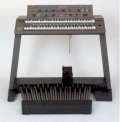

|
HX-1
The Yamaha HX-1 was the top of a series of HX- instruments, including HX-3 and HX-5 models in cases similar to the
HX-1 (see, for example, my
HX-3), and also including at least a CHX-1, which was the HX-1 in a wooden console surround (see below). The HXes were modular, in that each tone module (HX-1, -3, and -5) could be connected to either a dual 5 octave keyboard assembly, as shown here, or a dual 4 octave keyboard assembly (like my HX-3, above). Similarly,
three different pedal assemblies were available: 25 note console type, 20 note spinet type and 13 note spinet type.
The HX-organs, like the FX-1, used digital synthesis to produce their tones.
This HX-1 in the lower picture is shown with a pair of the rather substantial KA-40 amplified speaker units.
|
ÿ

|
CHX-1
The Yamaha CHX-1 was Yamaha's answer to those who wanted the power of the HX organs in a case that included some wood! Note that the cabinet merely surrounds what appears to be a standard HX tone module and Keyboard controller. From the grille cloth visible under the keyboard controller, it appears as though the CHX-1 also included internal amplification and speakers. I recently purchased a pair of cabinet-less KA-20 amplified speaker sets, and was told that they had been removed from a CHX-1, so perhaps the "standard practice" for CHX organs was to use the innards of a pair of KA-20s.
|
ÿ

|
GX-1
The Yamaha GX-1 wasn't really an organ, but a polyphonic analogue synthesizer in an organ-shaped cabinet. Each 61 note manual featured the equivalent of an 8-voice Yamaha CS-80 synth, the pedals contained a further monophonic (but multiple oscillator) synth, and the top 37 note manual operated yet a further mono-synth.
(The linked image is about 144K.)
|
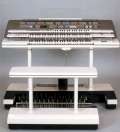

|
FX-1
The Yamaha FX-1 wasn't really an organ either, but, in this case, a group of polyphonic digital synthesizers,
presumably based on Yamaha's DX FM synth technology. Various level and balance controls were operated by
sliders, and in the FX-1, these sliders were automated, so that when a preset was recalled, the sliders actually moved to the preset positions!
|
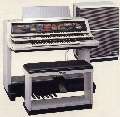
|
FX-3
A Spinet organ in a stage organ case, with an external speaker? It seems so. The FX-3 was presumably a cut down
presentation of FX technology. But, if it was a spinet, why put it in a stage organ case? (Or to phrase it another way:
"Why make a stage organ with 49 note manuals and 13 note pedals?"
|
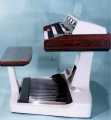
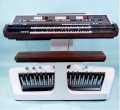
|
EX-21
We have no data on the EX-21 other than these images. It appears to be a fairly early analog organ. Note that it has both tone levers and rocker tablets, and dual expression pedals. Also note that the pedal key board has an unusually large (for Yamaha, that is) 32 note compass.
This instrument appears to feature both a solo mini-keyboard and a ribbon controller (to the left of the mini keys).
If anyone has further details of the EX-21, please email!
|
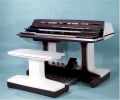

|
EX-42
The EX-42 looks to be a fairly complex standard analog organ, and from the tone lever organization, it seems as though the flute voices are mixed in along with the reeds and brass (red levers) and the strings (yellow levers), suggesting possibly that the non flute voices are simply organ-type filtered voices. It is not clear whether the two instruments shown here were different model organs or not, as there appear to be very few differences- some of the tone levers are not identical, and the piston arrangements vary slightly. Otherwise, they are quite similar.
|


|
EX-2
The EX-2 appears to be a cut down version of the EX-1, and is essentially an E-70 in a stage organ type of cabinet rather than the traditional wood console (see below). Note that it lacks the 37 note solo manual of the EX-1.
Warning-- the control panel close up is linked to a 126k image!
|

|
E-50
The E-50 appears to be a further reduced version of the E-70. The number of Flute voices is reduced (i.e., the white tone levers above the button fields) and the number of synthesizer voices is similarly reduced.
|
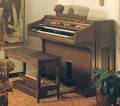
|
E-30
The E-30 is a yet-further reduced instrument from the E-50. It includes tone levers for both flute stops and fixed-filter organ stops (bassoon, oboe, kinura, string, etc.) as well as the synthesizer based "orchestra" section (including trombone, trumpet, saxophone, clarinet, guitar, banjo, accordion and 'funny'). This "orchestra" section, however, is the only synthesizer section in the E-30.
Check out the E-30
specification sheet.
(About 162K.)
|
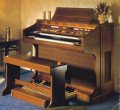
|
6000
I'm guessing this was a pretty late model analogue organ. It's mostly traditional organ, but the custom voices and special presets retain some synth characteristics. Functionally, this shares many similarities with the spinet 415 - though obviously it includes a few things the 415 doesn't, like extra flute pitches, and the three preset pistons, and it lacks the 415's solo synth.
Check out the 6000
specification sheet.
(About 140K.)
|
Selected Spinets. Yes, I know the FX-3 is up above...
Here the focus is on the more complex spinet organs, with some sort of synth built in, usually accessed from a third manual of short(er) compass.

|
D-85
The D-85 seems to be quite similar (or possibly identical?) to the 415. The only obvious difference is that the D-85 has a speed control for the rotary speaker (a little knob to the far right, between the lower and upper manuals - you can see the legend for it on the lower right side cheek block). So, possibly this is a later version of the 415?
Many thanks to Andres Gomez for sharing this image
|



|
D-80
Smaller than the 415, the D-80 continued the Yamaha tradition of providing spinet organs with a third manual
synthesizer-like section. On both the 415 and D80 organs, the solo synthesizer key widths are the same as the regular manual keys, however on the DK-40, the same 37 note synth keyboard uses obviously narrower keys
These close-ups show right and left portions of the D80 controls: the left includes the upper manual voices, various rhythm and accompaniment controls, ensemble routings, the upper manual orchestral voices, and controls for the 37 note Solo keyboard. The right includes the pedal and lower manual voices, foot-switch controller routings, and arpeggiator
controls.
|


|
DK-40
Yet still smaller than the 415 and D-80, the DK-40 was a fairly basic spinet organ, though Yamaha promoted it as having 'four' manuals. Four? Let me explain. Three of them are obvious: Lower, Upper and Solo (and note here that the Solo features 37 notes, but the keys are not the same width as those on the full sized manuals below). The 'fourth' manual is the ribbon controller to the left of the Solo keyboard, called the "Portamento" manual. The image here just barely shows it located forwardly of the two groups of rocker tablets to the left of the Solo keys. There are 4 green tablets which control the ribbon controller voices, and these voices are actually separate from the remaining voices on the Solo. Er, ah, but does it count as a fourth manual? You be the judge!
Check out the DK-40 specification sheet.
(About 127K.) Interestingly, this gives something of a part count as well. It must've been fairly early as there are apparently only 11 ICs in it!
|
Note: These images have been culled from all over. If you are the copyright owner of any of these images and object their/its use, let me know, and the offending image will be removed.
|
[ Back to 03. Electronic Organs | Main Index ]
|
|
| |



